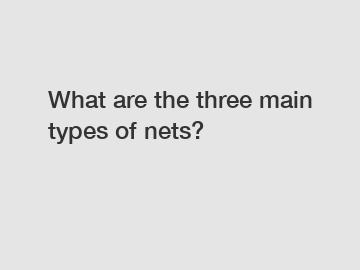What are the three main types of nets?
When it comes to fishing, one of the most important tools that a fisherman can have is a fishing net. Nets come in many shapes and sizes, and each type is designed for a specific purpose. In this article, we will explore the three main types of nets that are commonly used in the fishing industry.
The first type of net that we will discuss is the gill net. Gill nets are used to catch fish by entrapping them in the mesh of the net. These nets are typically made of nylon or monofilament line, and they are suspended vertically in the water column to catch fish as they swim by. Gill nets are commonly used in both freshwater and saltwater fisheries, and they are particularly effective at catching species like salmon, tuna, and sardines.
One of the key advantages of gill nets is that they are highly efficient at catching fish. The mesh size of the net can be customized to target specific species, and the nets can be deployed in a variety of configurations to maximize catch rates. However, gill nets have also been criticized for their impact on non-target species, such as dolphins, sea turtles, and seabirds. In response to these concerns, many fisheries have implemented regulations to limit the use of gill nets and reduce bycatch.

The second type of net that we will discuss is the trawl net. Trawl nets are large, bag-shaped nets that are dragged along the seabed or through the water to catch fish. These nets are typically used in commercial fishing operations, where they are deployed from fishing vessels to catch large quantities of fish in a single haul. Trawl nets can be equipped with a variety of accessories, such as doors and floats, to help them maintain their shape and position in the water.
Trawl nets are highly effective at catching fish, and they are used to target a wide range of species, including shrimp, cod, and haddock. However, trawl nets have also come under scrutiny for their impact on the marine environment. When dragged along the seabed, trawl nets can damage delicate habitats like coral reefs and seagrass beds, and they can also capture non-target species in their path. To mitigate these impacts, many fisheries have adopted more sustainable trawling practices, such as using smaller mesh sizes and employing turtle excluder devices.
The third type of net that we will discuss is the cast net. Cast nets are circular nets that are thrown by hand to catch fish in shallow waters. These nets are typically made of nylon or monofilament line, and they are designed to sink quickly and spread out on the seafloor to trap fish. Cast nets are commonly used by recreational fishermen and subsistence fishermen, and they are particularly popular in tropical regions where fish are abundant in shallow waters.
One of the key advantages of cast nets is their simplicity and ease of use. With a little practice, anyone can learn how to throw a cast net and catch fish. Cast nets are also highly selective, allowing fishermen to target specific species while minimizing bycatch. However, cast nets are limited in their range and effectiveness compared to gill nets and trawl nets, making them better suited for smaller-scale fishing operations.
In conclusion, fishing nets come in many shapes and sizes, each designed for a specific purpose. The three main types of nets that we have discussed in this article are gill nets, trawl nets, and cast nets. While each type of net has its own advantages and limitations, all three are essential tools for fishermen around the world. By understanding the different types of nets and their uses, we can help ensure the sustainability of our fisheries and protect the health of our oceans.
Contact us to discuss your requirements of conductive clothing, polyester screen fabric, polyester mesh fabric supplier. Our experienced sales team can help you identify the options that best suit your needs.
204
0
0

Comments
All Comments (0)